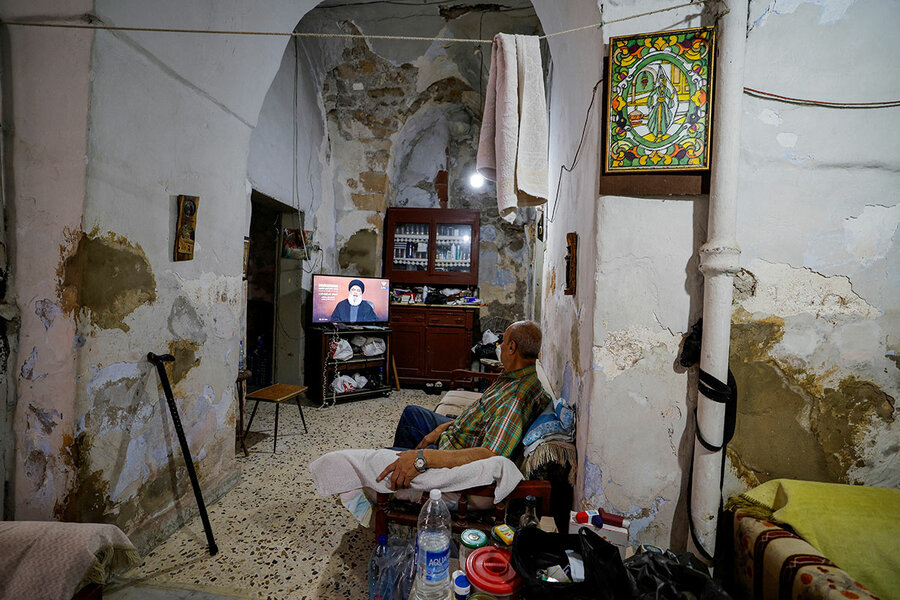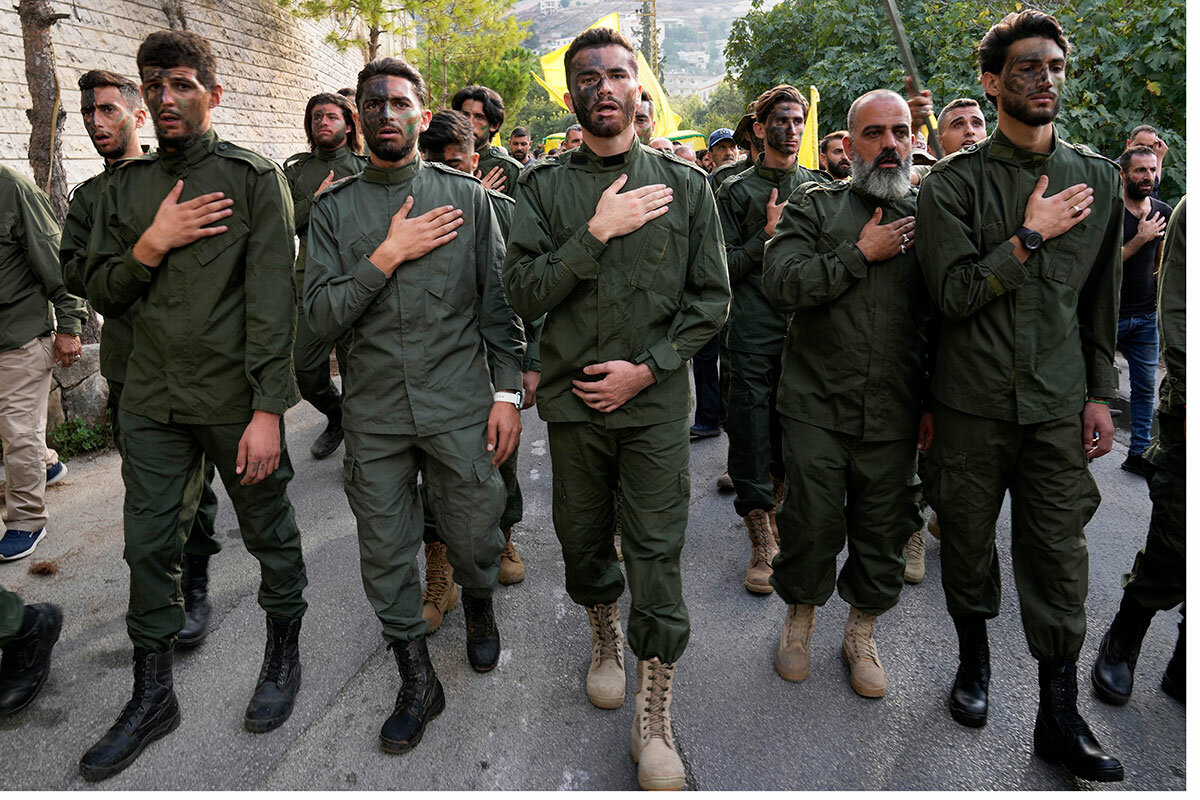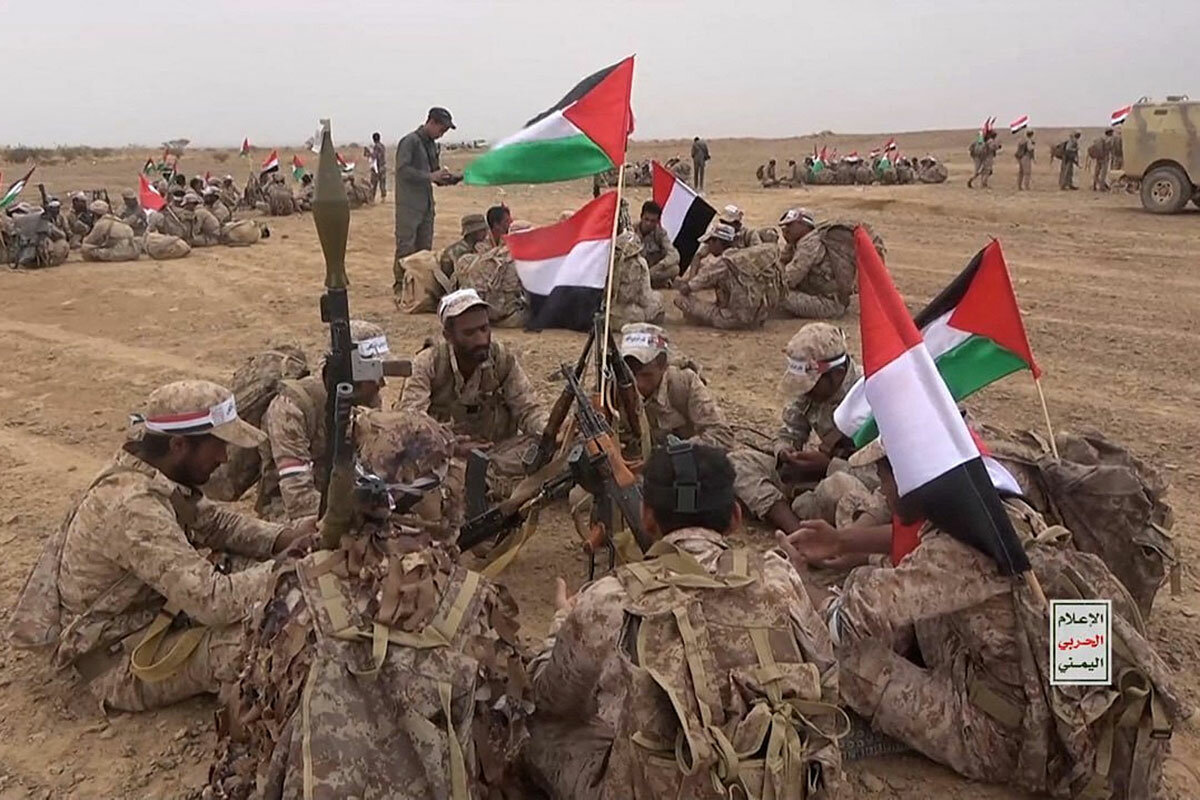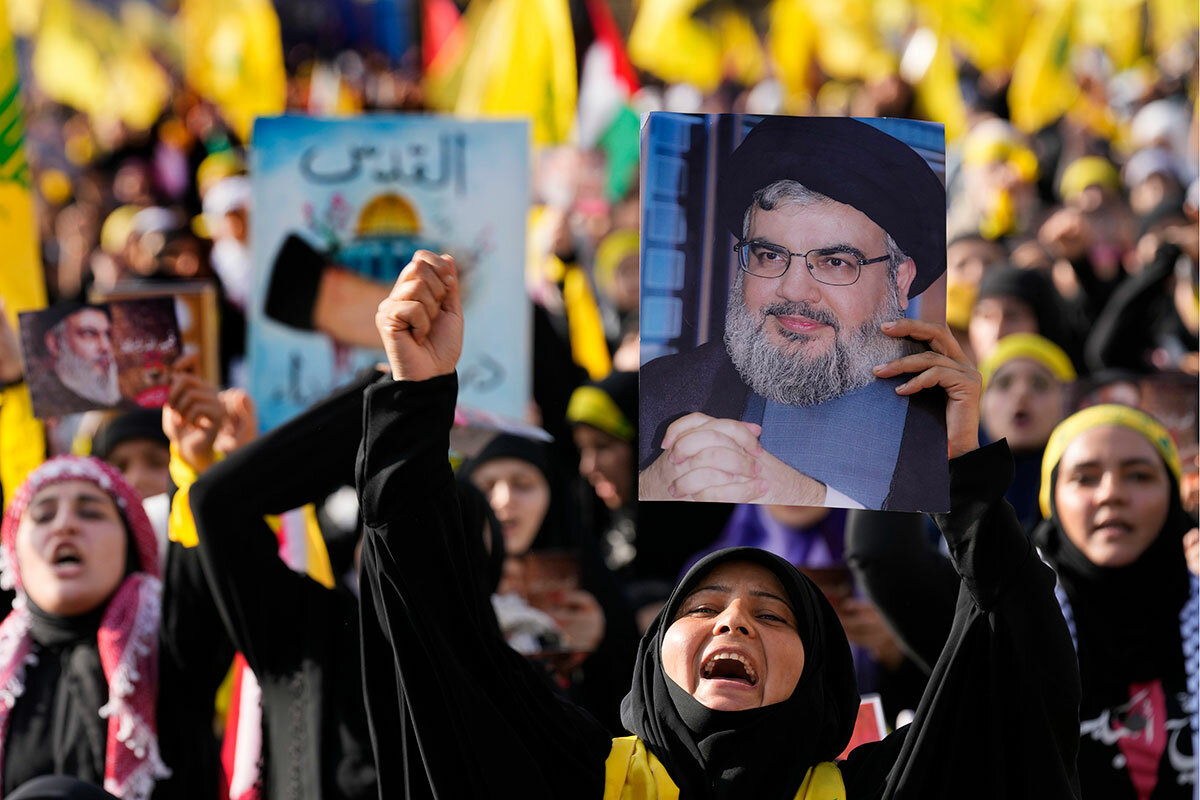The risks of wider war over Gaza, as Iran’s ‘axis’ activates
Loading...
| LONDON
Near Lebanon’s border with Israel, a Hezbollah missile specialist now braces for war like never before.
Wearing black tactical trousers, green camouflage, and a pistol – capped by a fatigued look that is by turns elated and anxious – the officer in the Iran-backed Shiite militia says his morale and expectations of imminent battle could not be higher.
That is because he believes Hamas’ surprise Oct. 7 raid, which left 1,400 Israelis dead and triggered an Israeli ground assault into Gaza, is heralding a broader, long-awaited fight against Israel and its staunch American ally by every regional armed wing of Iran’s self-declared “Axis of Resistance.”
Why We Wrote This
Around the Middle East, militias backed by Iran seem eager to join the fight against Israel in support of Hamas. To what degree will that happen? Will the war expand? That could depend largely on how Iran manages these groups.
“Oct. 7: We can call it the day of the beginning of the fall of Israel; that makes our morale shoot sky high,” says the Hezbollah veteran of 22 years, who gives the name Hassan.
“We can assure you, as Hezbollah, when we do receive the order to intervene and take sides with Hamas against the Israelis, immediately you will see the difference,” Hassan says. “We are definitely going to put a stop to all these massacres committed by the Israelis against the Palestinians.”
Indeed, from Yemen to Iraq and Syria to Lebanon, the range of offensive moves taken so far by the Iran-backed factions – which have been cultivated, armed, and supported for decades by the Quds Force of Iran’s Islamic Revolutionary Guard Corps – indicates that they have already been activated.
The jewel in the crown of that “axis” is the Lebanese Hezbollah, which is battle-hardened after a decade of war in Syria and has an estimated arsenal of more than 150,000 missiles that has for years ensured mutual deterrence with Israel.
Yet orders for an all-out Hezbollah assault on Israel were not announced Friday in Hezbollah leader Hassan Nasrallah’s much-anticipated first public comments since Oct. 7.
Mr. Nasrallah’s fiery rhetoric decried American “hypocrisy” and claimed there was no more critical fight than “against these Zionists,” but it masked a careful effort to navigate competing priorities and motivations for Iran, Hezbollah, and the other factions.
Hezbollah had increased its operations “day by day,” he said, taking a calculated “risk” to tie down Israeli troops to benefit Hamas.
“We are ready for all possibilities,” Mr. Nasrallah said. “Whoever wants to prevent a regional war, and I am talking to the Americans, must quickly halt the aggression on Gaza.”
Iran has applauded the Hamas assault, which harnessed years of clandestine Iranian support with arms, cash, and weapons-building technology to inflict the gravest attack on the Jewish state since its founding in 1948.
But the shock of that savage attack has also prompted a ferocious Israeli response, including more than 10,000 air and missile strikes – and a ground offensive bent on destroying Hamas altogether. Some 9,000 people have been reported killed in Gaza since Oct. 7.
Already Yemen’s Shiite Houthi rebels have fired three batches of missiles and drones more than 1,000 miles toward Israel. Iran-backed Shiite militias in Syria and Iraq have likewise mounted dozens of attacks against American troops in those countries.
And Hezbollah has engaged with Israel in attacks that are gradually claiming more lives on both sides and expanding deeper into each other’s territory – including simultaneous strikes Thursday against 19 Israeli targets.
Iran: Success vs. setback
“If the Israelis don’t topple Hamas in Gaza, if they do a ground incursion and then withdraw, then it would be a major victory for the whole ‘Axis of Resistance,’” says Fabian Hinz, a Berlin-based expert on Iranian and regional missile capabilities at the International Institute for Strategic Studies.
For the Iran-backed militias, past progress has usually been measured by episodes of conflict that afterwards created new levels of deterrence and capabilities against Israel, he says, without going so far as to risk the destruction of any single group.
But the sheer scale of the Hamas attack may prove to be a “major miscalculation,” says Mr. Hinz, by changing that gradual trajectory and triggering such a powerful Israeli response against Hamas that possibly no action – even from Hezbollah – could stop it.
“This carefully built-up deterrence ... [leading] to Hamas having tens of thousands of rockets and being able to make a ground incursion – basically all of that was gambled away by Hamas in that attack,” adds Mr. Hinz.
“If you [the ‘axis’] are not able to deter the Israelis from marching into Gaza, it is a major setback,” he says. “It’s a very high-stakes game.”
The Palestinian cause and anti-Israel venom have been an ideological pillar of Iran’s leadership since the 1979 Islamic Revolution. Iranian officials boast that Palestinian militants, who once fought with stones, knives, and slingshots, today use rockets, ballistic missiles, and drones from Iran – in a transformation that Iran has repeated across its proxy militias.
“The hands of all parties in the region are on the trigger,” Iranian Foreign Minister Hossein Amir-Abdollahian warned last week, as Israeli tanks moved into Gaza.
Iran’s calculations
Iran has denied any direct role in the Hamas raid. Yet in the current battle, Hamas leaders have called on Hezbollah and Iran to do more to help them.
“I don’t think the Iranians want to sacrifice Hezbollah on the altar of Hamas, because at the end of the day, Hezbollah is a prime component of Iran’s deterrent strategy,” says Nicholas Blanford, a Beirut-based Hezbollah expert with the Atlantic Council.
“If you tell Hezbollah to go full-on with Israel, irrespective of the outcome, Hezbollah is going to take a battering, and there is no guarantee they’ll be able to reequip and rearm as quickly as they did after 2006, to continue serving as deterrence for Iran,” says Mr. Blanford, author of “Warrior of God: Inside Hezbollah’s Thirty-Year Struggle Against Israel.”
“I sense cooler heads prevailing for now, but that is a logical assessment,” he says. “I think the Iranians are logical, but the calculus may change, given the carnage in Gaza.
“I can see a lot more activity” along the Lebanon-Israel border, such as drone attacks, limited incursions, and ambushes, “to keep it all bubbling along,” says Mr. Blanford. He notes that Hezbollah’s options short of all-out war include “many, many shades of gray.”
The rockets and drones fired by Yemen’s Houthis have so far all been shot down, either by American warships in the Red Sea or Israel, or landed in Egypt or Jordan. But Abdelaziz bin Habtour, the prime minister of the Houthi government that controls Yemen’s capital, Sanaa, said this week that Houthi forces would continue strikes as “part of the ‘Axis of Resistance.’”
There is “one ‘axis,’ and there is coordination taking place, a joint operations room, and a joint command for all these operations,” the Houthi politician said.
What the Houthis gain
“This is Iran’s investment in the Houthis manifesting itself,” says Nadwa al-Dawsari, a Yemen expert with the Middle East Institute in Washington.
“The Houthis were guerrilla fighters in the remote north of Yemen, but the Iranians have been training them for at least the last 20 years, [with] IRGC [Islamic Revolutionary Guard Corps] and Quds Force commanders on the ground, helping them develop missile and drone technology,” says Ms. Dawsari.
“Iran has made the Houthis what they are,” she says.
At the same time, taking part in the fight against Israel as part of Iran’s transnational “axis” also serves the Houthis at home, where criticism has grown over their ineffective rule during a year and a half of relative peace.
“Internally, the Houthis need war, in order to justify controlling the population without governing, so this is like a dream come true,” says Ms. Dawsari. “It is also a great opportunity for the Houthis to gain popularity and recruit fighters.”
Closer to Israel, on Lebanon’s southern border, Hezbollah missile expert Hassan – whom friends say is a “true believer” – recalls telling the Monitor in Beirut in August that his “main fear is to die without liberating Palestine – but we can see it getting closer.”
After Oct. 7, what did Hassan tell his family, when he left for this southern front?
“I told my family: Pray for me. God willing, I may become a martyr on the road to Palestine.”
A Lebanese researcher contributed to this report from near the Lebanon-Israel border.










